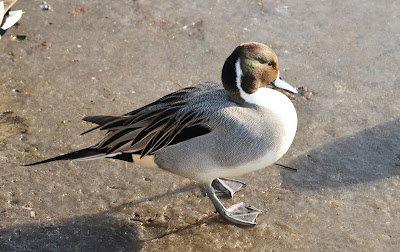Today I am sharing more birds from my Reifel Bird Sanctuary visit; this time the photos are of birds I haven't seen before.
First is the Northern Pintail Duck:
"Slim and long-necked, the Northern Pintail has a distinctive silhouette. The male is easy to identify by his striking markings and long tail, but even the female can be recognized by her graceful, long-necked shape."
https://www.allaboutbirds.org/guide/Northern_Pintail/id (all Pintail quotes)
All these pictures are of the male Pintail ducks.
"Chocolate-brown head. White neck and underparts, white extending up back of neck in thin line. Very long black central tail feathers. Black rear end bordered by yellowish tan patch. Sides and upper back gray. Lower back feathers long and black with pale edges. Rear of wing (speculum) bronzy greenish with black band and white rear edge. Bill black with bluish gray stripes. Eyes dark brown. Legs gray."
"Like the Mallard, the Northern Pintail breeds in a variety of habitats all across northern North America and Eurasia
The Northern Pintail is among the earliest nesting ducks in North America, beginning shortly after ice-out in many northern areas."
"The oldest recorded Northern Pintail was a male and at least 22 years, 3 months old when he was found in Saskatchewan, Canada."
"Nests in open country with shallow, seasonal wetlands and low vegetation. Winters in wide variety of shallow inland freshwater and intertidal habitats."
Eats "grain, seeds, weeds, aquatic insects, crustaceans, and snails."
"Northen Pintail populations declined throughout most of their range at a rate of 2.6% per year between 1966 and 2012, resulting in a cumulative decline of 72%, according to the North American Breeding Bird Survey. The 2014 State of the Birds listed them as a Common Bird in Steep Decline."
Here is a video showing the courtship behavior:
---------------------------
I was lucky to see some owls, although they were both totally disinterested in me:
First here is a Great Horned Owl high up in a tree. You can see one of its "feather ears" in the centre of the picture.
"With its long, earlike tufts, intimidating yellow-eyed stare, and deep hooting voice, the Great Horned Owl is the quintessential owl of storybooks. This powerful predator can take down birds and mammals even larger than itself, but it also dines on daintier fare such as tiny scorpions, mice, and frogs. It’s one of the most common owls in North America, equally at home in deserts, wetlands, forests, grasslands, backyards, cities, and almost any other semi-open habitat between the Arctic and the tropics."
This is a picture from the above website, just so you can see the whole owl:

and here is a video of the owls voice:
This my second owl, a back view of a sleeping owl, this one is a Saw-whet Owl.
"A tiny owl with a catlike face, oversized head, and bright yellow eyes, the Northern Saw-whet Owl is practically bursting with attitude. Where mice and other small mammals are concerned this fierce, silent owl is anything but cute. One of the most common owls in forests across northern North America (and across the U.S. in winter), saw-whets are highly nocturnal and seldom seen. Their high-pitched too-too-too call is a common evening sound in evergreen mountain forests from January through May."
Here is a video of the Saw-whet Owl and sample of its "voice":
----------------
Here is another shy bird, I only saw it because another birder pointed it out.
The is a Virginia Rail:
"A secretive bird of freshwater marshes, the Virginia Rail most often remains hidden in dense vegetation. It possesses many adaptations for moving through its habitat, including a laterally compressed body, long toes, and flexible vertebrae."
Video of Virginia Rail feeding and calling:
-----------------------------------
These last were in a distant field and I couldn't tell whether they were Swans or Snow geese. My guess would be swans because I think they are too big for Snow Geese.
I only had one chance for a picture before they flew off. What do you think they are?
--------------------------------
Well that is all for this week, thank you for dropping by,
happy Wednesday, with whimsy,
Gillian.















No comments:
Post a Comment